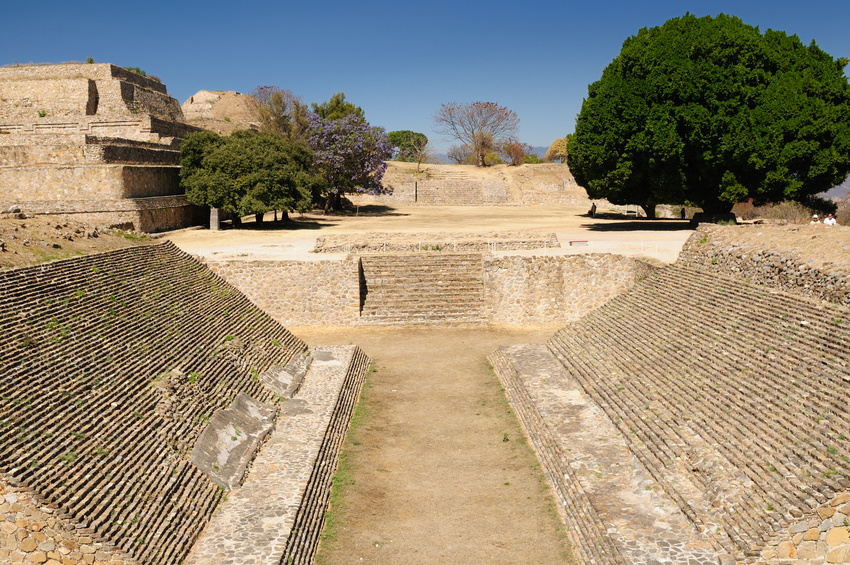 For travelers on short schedules who are not able to visit any of the surrounding towns or other attractions in the Oaxaca area, at least go and see Monte Alban. These historical ruins are among the most impressive in all of Mexico. Most of the ruins have been restored to their original splendor but some of the original structures can also be seen. This site was occupied by the Zapotec Indian tribe between 800 BC and 400 BC. Archaeologists and anthropologists speculate that it was built to serve as a religious and governmental center for people living in the three nearby valleys.
For travelers on short schedules who are not able to visit any of the surrounding towns or other attractions in the Oaxaca area, at least go and see Monte Alban. These historical ruins are among the most impressive in all of Mexico. Most of the ruins have been restored to their original splendor but some of the original structures can also be seen. This site was occupied by the Zapotec Indian tribe between 800 BC and 400 BC. Archaeologists and anthropologists speculate that it was built to serve as a religious and governmental center for people living in the three nearby valleys.
Monte Alban is located about 3.5 miles west of central Oaxaca. One could walk here in about 90 minutes; we met travelers who made this trek. I walked half way in about 45 minutes but that was easy walking. I only went as far as the flats and then the road became quite steep. Monte Alban is situated on several tall hills. The original natives removed large amounts of earth from the tops of the hills; then they built structures on these flattened areas.
The history of Monte Alban is generally divided into 5 phases. The first phase around 200 BC was when the hilltop was leveled and the town grew to around 10 thousand people. The next phase was from 200 BC to about 300 AD when the city became more and more dominant. Lots of pottery was found from this time. The third phase was from 300 AD to about 700 AD. This time period was when the city was at its peak in population and wealth. The height of the population at this time was around 30,000. Most of the stone structures that are standing today date from this era. Monte Alban during the 4th period from 700 to 950 AD was abandoned. My guide said that people are still unsure why the city was abandoned. He speculated that earthquakes may have had something to do with the disappearance of the population. He also said that the resources in the area just may have not been able to support the large population.
The last period was from 950 to 1521. The town was minimally inhabited but the tombs were reused to bury important people. These personalities were buried with numerous riches – now housed in Oaxaca’s regional museum.
The knowledge these early people had about astronomy and mathematics is amazing. My guide pointed out numbers inscribed in some of the rocks. He also showed our group areas where the sun only strikes at a certain hour on a certain day of the year.
The middle of the large “plaza” is an impressive place – one is surrounded on all sides by steep stone steps. The ball court is equally as impressive. Ball courts were used throughout Mexico and central America. Some of the ball courts were the scenes of human sacrifice in places like Guatemala. There is no sign of human sacrifice at Monte Alban, only animal sacrifice. The ball court is surrounded by 15 to 20 foot vertical walls. Two teams face off and players use their hips to hit the ball. Our guide said researchers are still undecided on how exactly the game was played.
As you tour the ruins you will most likely be approached by vendors selling a variety of replicas. Most of these vendors are descendants of various Indian tribes. They will try to sell you their goods at an incredible mark up in price. If you are interested in their products, in order to pay a fair price you must bargain. And bargain hard.
Its amazing some of the excuses these vendors will tell you to justify their high price. One vendor told me his jade mask was more expensive then the one I had already purchased because his mask was made by a Mixtec Indian and the one I had was made only by a Zapotec Indian. I could clearly see that the masks were of similar quality and made of the same stone and were the same size.
A museum is located at the entrance to the ruins. Entry fee is a few USD. The fee includes entrance to the ruins but not a private guide. The guide I hired cost about 20 dollars American and the tour lasted approximately an hour.


Leave a Reply